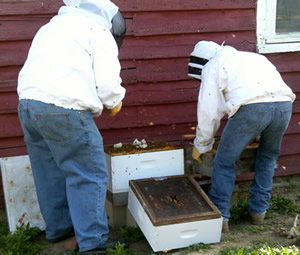Backyard Beekeeping
HOMEGROWN EXPERT GARDENING ADVICE
Big Benefits of Backyard Beekeeping
Beekeeping can be an interesting hobby, plus you can turn it into a money-spinning business later on. As you probably know, the demand for honey is booming nowadays. In fact, honey consumption in the U.S alone reaches more than 300 million pounds yearly. Evidently, honey is an extra special product with a huge chunk of worldwide market waiting for you to satisfy.

What’s great about beekeeping is that all related cost of producing it are minimal. It also takes less time and effort on your part. So to help you get started, here are some quality beekeeping tips and guidelines. With patience and results-driven mindset, you can make money while enjoying the liquid gold, honey. Other sweet rewards that make folks so attracted to beekeeping also include pollination and products such as royal jelly, beeswax and propolis.
Beekeeping Benefits
Harvesting honey – No other honey tastes as delicious as the honey produced by your own bees. Beekeepers would agree that bottling your own honey is quite fascinating. Additionally, you know it’s real, fresh and clean honey. Expect to produce about 100 pounds or more for a single colony, although the amount of production is usually affected by external factors such as the strength of your colony, your location, weather and rainfall.
Low investment – Beekeeping requires minimal space or no land. It generally needs low technology and only requires simple tools like a smoker, protective bee suits, a hive tool, a bee brush or anything soft-bristled that won’t harm the bees, supers, frames, wax and of course, beehives. Even time management is not a problem because beekeeping allows you to do your normal workday routine. It is not a time consuming activity and only involves checking the hive about 10 times a year, often during spring and summer. During autumn and winter, beehives are inactive.
Provides income – Honey is a marketable commodity because it can be traded locally and internationally. It is a high value product with many uses and has a lucrative supply. Nevertheless, beekeeping is not limited to harvesting honey. As what was mentioned earlier, it also opens a multitude of income-generating projects such as beeswax for candle-making. Honeybee by-products are a valuable food source and can be used as medicine or dietary supplements. Plus, they have a long shelf life! Beekeeping basics are easy to learn, yet it provides opportunity for quick return of investment.
Bees as pollinators – Any gardener recognize the importance of pollinating insects to have a bountiful garden. Keeping a hive in your garden/ backyard improves pollination which significantly adds value to harvested fruits, nuts, trees and plants. Bees play a big role in copious production of seeds and fruits. In fact honey bees account for 80% of entire pollination done by insects.
Extracting honey from a beehive involves several steps. Here's a general overview of the process:
Prepare Equipment:
Ensure you have the necessary beekeeping equipment, including a bee suit, gloves, smoker, hive tool, honey extractor, uncapping knife, and buckets for collecting honey.
Choose the Right Time:
Pick a time when the majority of bees are out foraging, typically during a sunny and warm day. This reduces the number of bees in the hive, making the process easier and less disruptive.
Use Smoke:
Light the smoker and use it to calm the bees. Smoke disrupts their communication and makes them less aggressive.
Remove Supers:
Remove the supers (the boxes where honey is stored) from the hive. Be careful not to damage the comb.
Uncap the Honeycomb:
Use an uncapping knife to remove the wax cappings from the honeycomb. This exposes the honey for extraction. You can also use an uncapping fork or roller.
Extract Honey
Place the uncapped frames in a honey extractor. This is a device that uses centrifugal force to spin the honey out of the comb. The extractor will spin the frames, causing the honey to fly out of the cells and collect at the bottom of the extractor.
Filter Honey
After extraction, the honey may contain bits of wax or other impurities. Filter the honey through a fine mesh or cheesecloth to remove these particles.
Collect and Store Honey
Collect the filtered honey in clean containers. Use food-grade buckets or jars for storage. Seal the containers to prevent moisture absorption and crystallization. Store honey in a cool, dry place.
Return Frames to Hive
Return the frames to the hive for the bees to clean. They will remove any remaining honey and clean up the empty comb.
Monitor and Maintain Hives
Regularly monitor your hives and perform necessary maintenance to ensure the health and well-being of your bees. It's important to note that while extracting honey, you should be gentle and avoid harming the bees. Also, be mindful of the amount of honey you take, leaving enough for the bees to sustain themselves through the winter. Additionally, follow any local regulations or guidelines related to honey extraction and beekeeping in your area.
The Stinging Fact
Whether you want to start a hobby, be a master of making honey or want to run a thriving business, you will need correct beekeeping information or else you could make costly and painful mistakes. Beekeeping comes with a big warning so always wear layers of protective clothing. Bee sting can be fatal in rare cases but most people do not react badly to bee stings. In case you have nasty allergic reaction to bee sting, it’s probably best to give a serious thought to beekeeping.